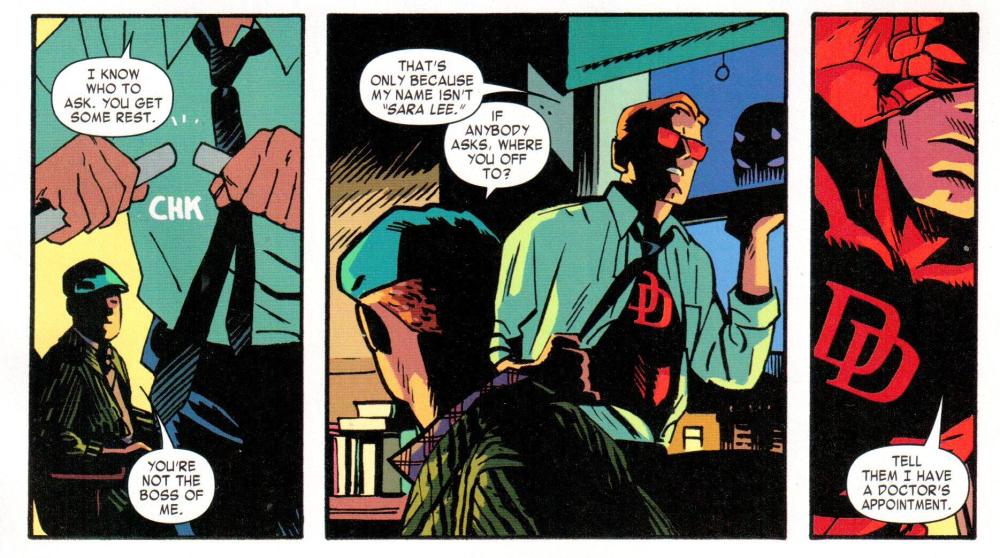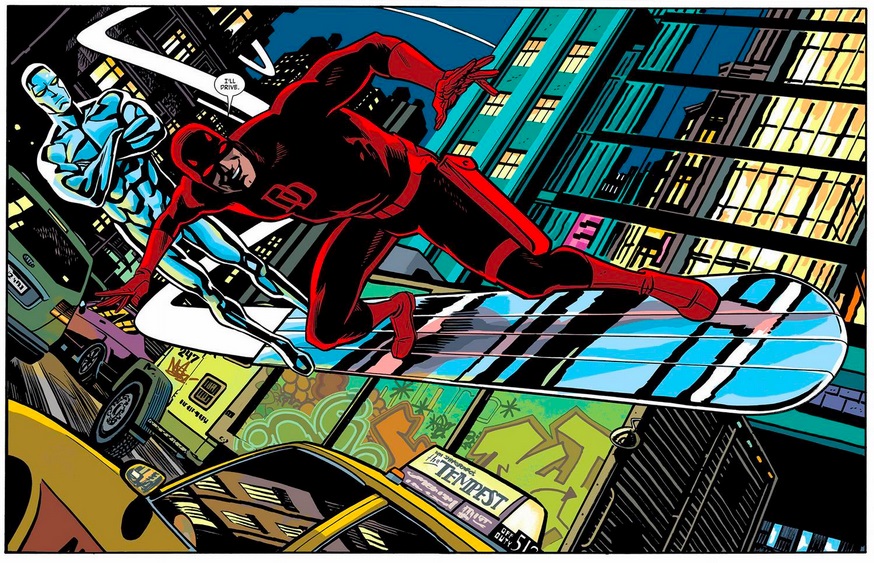Written by the 13th Dr. Sean & edited by Earth-2 Mike
[Spoiler Alert! This article discusses Daredevil volume 3]

When did comics jump the proverbial shark? Was it the dawn of graphic novels or comics domination of the movie industry? Was it specific stories such as “One More Day” (2007) or “Flashpoint” (2011)? Was it grander changes like DC’s “New 52,” and Marvel NOW? Regardless of the catalyst, the reality is that comics today have never been worse. Volume of sales is down, while the price of a comic is up, with both of the two major companies sprinting past the $2.99 line they previously claimed to have drawn in the proverbial sand. As readers sit on the precipice of change yet again, with DC’s upcoming “Convergence” and Marvel’s “Battleworld,” it would seem there is little hope for improvement. However, all may not be lost. There is one book that offers both companies insight into the ingredients of a good comic book; Mark Waid’s Daredevil.
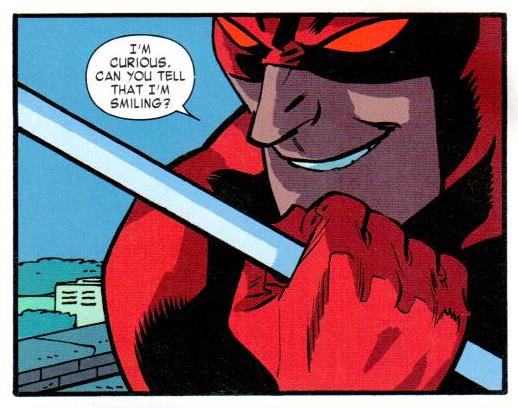
Hindsight has shown that September 2011 was an auspicious time in comic book history. DC launched the “New 52,” the younger, edgier, higher collared, worst of the 1990’s throwback universe, where Superman looked like Lil’ Abner and acted like a moody douche bag, and words like douche bag became standard in every heroes vernacular. It is amazing to think a universe that started with Batman being hunky-dory with Flash confessing to genocide as a result of failed time travel would not produce high quality comic books, but sadly this was the state of DC at the time.
While DC was busy producing 52 monthly examples of what not to do with comics, all hope was not lost in comic confines of Hell’s Kitchen as September 2011 would also see Mark Waid begin his run on Daredevil. Under the guise of the Marvel NOW mast, Waid and crew unknowingly began creating one of the best superhero comics of the Modern Era. Utilizing classic storytelling techniques with beautiful art and a riveting plot, Waid’s Daredevil is a modern masterpiece that both DC and Marvel should look too for pointers on how to reverse the tragic decline of the state of comics. So what is it about Daredevil that sets it apart from all the rest of modern superhero comics, well DC and Marvel, sit back, grab a pen, and prepare to take notes on the elements of what comprises a rewarding comic.
First and foremost, what Waid does that is so often overlooked, especially as both companies are preparing to hit the reset button yet again, is to acknowledge the past and keep moving forward. The “New 52” is just another example in a series of retcons that both DC and Marvel are guilty of. “Crisis on Infinite Earths,” “Flashpoint,” and “One More Day,” are all examples of times when companies felt the best choice would be to either forget, or consciously choose to ignore stories that have come before. The irony being, these stories that they choose to ignore are the same ones they once told us mattered a great deal. When Mark Waid came onto Daredevil, the character had just completed an arc that began with the death of Matt Murdock’s love Karen Page followed by his identity as a crime fighter being outed. Lest we forget his new love interest, and eventual ex-wife, was left babbling in a mental hospital, while Matt was spending a period of time in jail, and ultimately ended the series with him being possessed by a demon and setting up shop as the new Kingpin of New York. To say things were bleak for the Man Without Fear is an understatement.
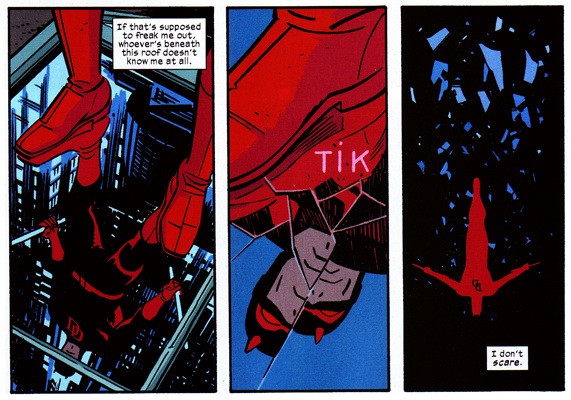
While that volume, with the exception of “Shadowland,” was a wonderful series that showed a very tortured hero, it is amazing that Matt did not just kill himself given the state of his life at the time. It is fair to say anyone, especially a fan new to the character, genre, or medium, looking to follow that Daredevil series would have their work cut out for them, and the easiest thing to do would be to wave the wand of retcon, and start the character from scratch again. That is not what Mark Waid did. Instead of running from a history of death, depression, and demonic possession, Waid charges head on to the challenge, giving readers a 180 degrees different Matt Murdock, while continuing to reference the “old Matt” stories. Rather than shy away from the complexities of continuity, Waid embraces it, and uses Foggy Nelson as the voice of the readers, constantly questioning Matt’s now jovial persona. There is no doubt that trying to make sense of years of continuity is a challenge for every comic writer, but Waid did it with Daredevil, and he is not alone. Geoff Johns used to excel at just this sort of thing, making sense of both Green Lantern and Hawkman’s convoluted pasts, prior to becoming one of the people in charge. The result of this kind of storytelling, were stories that appealed to both new readers and longtime fans, and demonstrate the value of acknowledging what a character has already been through while using it to propel them forward.
Waid gave readers a version of Matt Murdock more akin to the original Matt of the 60’s, a character that had not really been seen since before Frank Miller’s legendary run. What made him different from the “old Matt” was that he was happy and fun loving. It seems silly to think that such a concept, like a superhero who actually enjoys being a superhero, would be what sets them apart from modern comics, but sadly this is the case. Matt still had a difficult past, ripe with reasons to want to be miserable, but Waid refused to let that stop Matt from enjoying his role as Daredevil. As early as the first issue of Waid’s run, Daredevil grabs the bride, the daughter of a mobster, and, like the cavalier adventurer he is, kisses her, showing the readers exactly what they can expect from the “new Matt.” He is no longer the character wallowing in loves lost, but instead is now seen kissing the “damsel in a distressed white dress” while completely surrounded by mobsters aching to kill him. He is bold, charismatic, confident, and most importantly, having fun. A quality also seen when Daredevil “races” Spider-Man from the top of a building to the bottom (issue #8). The bride is not the only welcome surprise at the wedding as Waid, and artist Paolo Rivera, effortlessly reintroduce low level villain the Spot as a weird, otherworldly threat without having him ever utter a word. The two make him the kind of reality-bending, panel-busting foe that could only work in the medium of comics.
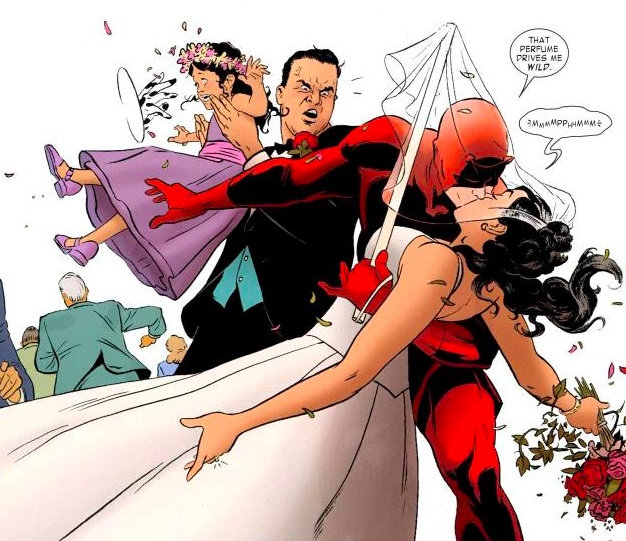
What comic book reader does not dream of being able to do half of what the heroes they read about do everyday? Readers could imagine experiencing the New York skyline from the top of a skyscraper, only to then throw oneself off, racing ever closer to the street below, averting certain death by throwing a thin grapple line and swinging off into the night, adrenaline pumping with excitement and a feeling of invincibility. That is what comics were all about… 50 years ago. Today’s comic seem to be about nothing more than pain, trauma, and tragedy. Over at DC, their resident “man without fear” Green Lantern, can not enjoy wielding the most powerful weapon in the universe limited only by his own imagination and willpower, because every time he does, he slowly drains the life blood of the universe. Every boxing glove and sledgehammer Green Lantern creates, brings the universe one step closer to destruction. Great. There goes all the fun of being Green Lantern. Comics allow readers temporary escape from the everyday, but who wants to escape to a world where even those who can fly are just as miserable? Why is the era of comics where heroes were happy and heroic, considered outdated and campy?
Thankfully Waid’s Daredevil is a refreshing break from the down-in-the-dumps hero who never appreciates their unique abilities and impact they make in their role as savior. With one kiss in the first issue, Waid recaptures the exuberance of the Silver Age, without ever making it feel campy or lame. Waid is helped along this path by a Who’s Who (or should that be a Handbook’s worth?) of top level artistic talent. Paolo Rivera, Marcos Martin, and eventually Chris Samnee have the classic sensibilities to evoke an earlier age but they never stop showing us why this book is not out of place today. In an early arc Matt, the Devil who Dares, ventures into a literal Underworld as the Mole Man threatens our hero. Matt’s blindness is played as part of the reason he is without fear: He cannot see the Old School Giant Monsters that surround him at every turn in the pitch black caverns he has not so wisely ventured into. Matt is none the wiser and the art conveys that flawlessly. This is a title that rewards patience and always makes the cover price seem as if it were a bargain.
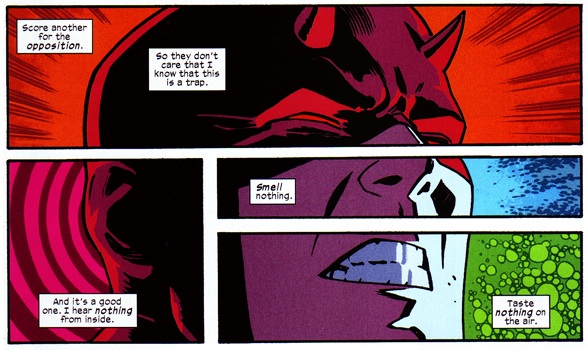
When Daredevil first saw print in April 1964, comics were primarily purchased by young readers at their local newsstand, who were not able to come religiously and purchase every issue. As a result of this, comic companies were producing stories that were short and concise, so that they were accessible to everyone regardless of whether or not they read the last installment. Flash forward a few decades to the dawn of the graphic novel, and suddenly comics were no longer written to be short and sweet, but rather long winded and painfully detailed, to ensure enough content for at least a six issue collection. This followed the gradual increase in the average age of the fans and the increase in disposable income that came along with that. A dime for a four-color adventure is comparable to a single trade paperback for the twenty something. Stories that were meant to be two or three issues, were now five or six, with the extra material serving little purpose to the plot.
Now, this article has been picking heavily on DC, but this phenomenon is not limited to them. Both Marvel and DC are guilty of incentivizing writers to “write for the trade.” The result is that local comic shops are flooded with graphic novels, full of stories that drag on and on, while comics are full of stories that overstayed their welcome. Mark Waid shows with Daredevil, the art of telling short stories while weaving in a subtle, bigger plot, for those that read religiously. He gives stand alone stories, such as the Eisner Award winning issue #7 about Matt helping a bus of blind children stranded in the snow, or a two parter where he has to defend his old schoolyard bully, while also weaving villains such as Ikari, the Coyote, and even Doctor Doom (sort of) into a larger tapestry ultimately culminating with Bullseye. Waid shows foresight and care with his writing, using the classic style of comic storytelling to his advantage, keeping the book fast paced and seemingly unconnected, only to pull all the threads together revealing the larger picture he spent years building to, and in doing so, elevates the series. Most standout is the fact that Daredevil does not require the fan to read any other title. What other major superhero title can claim that?
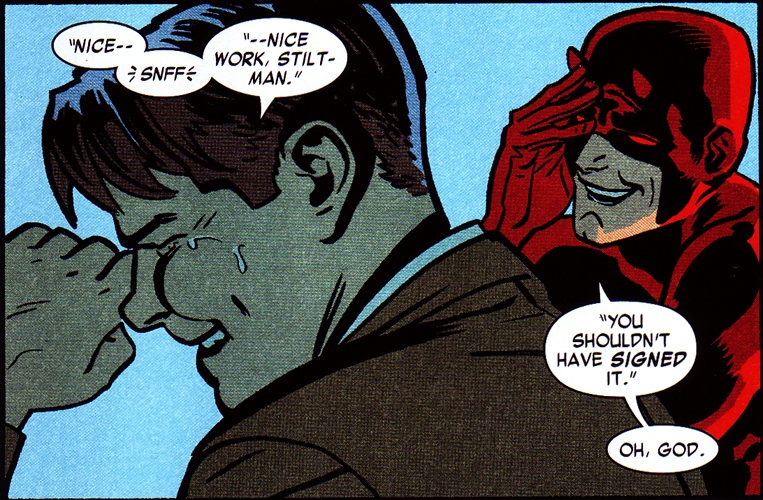
An important consideration of Waid’s Daredevil series is that the stories are never about Matt preventing the end of the world. The universe was never in peril, the skies were not red, and yet there was still danger and excitement. Mark Waid understands that it is okay to keep it simple. There were personal stories such as Foggy Nelson having cancer, or Battlin’ Jack’s remains being desecrated. There were super villains such as Mole Man, Klaw, and Lady Bullseye, but still, their threat was far more myopic, and yet equally sinister. They never needed to threaten the whole world, because they were threatening Matt’s loved ones, and thereby his whole world. In today’s comics, both Marvel and DC are plagued with event-books which has led to fatigue on the part of the readers, constantly moving from one Earth shattering catastrophe to another, never pausing to tell a simple story about the good guy beating the bad guy.
Daredevil, at his roots, is a street level hero. There is a reason his rogues gallery consists of Kingpin and the Owl, not Galactus or Thanos. Please understand, some characters like Superman need to have omega level threats to match their power, just as comics would get boring if the world were never threatened, but that does not need to be the focus of every story. One could even argue that some of the best Superman stories were not the ones where he saves the universe, but rather the ones that focused more on the “man” and not the “super.” Stories such as Jeph Loeb and Tim Sale’s “Superman For All Seasons” or Garth Ennis and John McCrea’s “Hitman” #34, are great because they show readers that it is not his powers that make him a hero but his values. Foggy makes the same argument about Matt, describing his integrity as his greatest power. No long, cumbersome exposition, but simple, direct thoughts and quotes that reward rereading time and again.
Super powers are great because they allow readers an opportunity to embrace their imaginations, but if every story is about the world ending, or Metropolis or New York City getting destroyed, then who would ever want to live in that world? Waid shows that a story can be just as exciting, and rewarding, when it focuses on its main character. Just as in the 60’s, Matt is defending Hells Kitchen, and, more importantly, his friends. He will step up and take down organized Megacrime when the opportunity presents itself, or run off to Latveria to face Dr. Doom (sort of), but his first priority is to his friends and his neighborhood, including the clients he has in his professional life. Matt is the eternal fan of the underdog and if his super-heroics prevent him from helping then he finds another way. Matt will not sacrifice one part of his life for another and thus often pays the consequences of such hubris. What separates him from the racks filled with similar stories is that Matt keeps moving forward. He does not let failure or radical life changes prevent him from remaining true to himself. There are no Daredevil clones, deals with Devils, or time travel shenanigans to help him go back. Madness is part of Daredevil, both story and character.
This idea of telling personal stories and not just universe shattering ones, leads to the next thing Waid does that is sadly lacking in many comics of late, that is, to know thy characters. There is no mistake that Waid found Matt Murdock’s voice, but with the aid of is amazing art team, including Chris Samnee, his longest running co-creator, they found his vision too. The way Daredevil’s radar sense is brought to life is both incredibly simple, and yet visually impressive, and is guaranteed to leave a resonating effect for future Daredevil teams if for no other reason than it is the most major contribution to a character more than five decades old. Through forethought and sheer brilliance Daredevil comes to life because it is clear the creators have put thought into every little detail. Another prime example can be seen in one simple panel. In issue #16, Daredevil has just regained his radar sense, and awakens to “see” three familiar people; Doctor Strange, Hank Pym, and Tony Stark. How this simple scene is both narrated and illustrated, with Matt describing the unique characteristics of the familiar heartbeats, specifically detailing the rhythmic beat of Tony Stark’s due to the aid of the machinery keeping him alive, and the panel showing three heartbeats, with one resonating from a focal source in the middle of one’s chest, demonstrates that this is no longer just a comic book, but instead a true work of art.
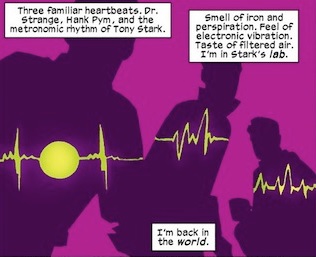
The final thing Waid does when crafting his Daredevil series, is carefully choosing when to sprinkle in appearances by other Marvel characters. Hank Pym’s Ant-Man, Iron Man, Spider-Man, and Punisher each make an appearance, but in ways organic to the story, and they do not happen in every issue. The book is about Matt Murdock, and while yes, he may exist in a larger Marvel Universe, Wolverine is not showing up just to boost sales. Waid recaptures the “event book” of the Silver Age, by having the event be an appearance of another hero; particularly characters you would not expect to see. When Silver Surfer shows up in issue #30, that is the big event. In classic comic form, the two heroes meet, fight, and then befriend one another to solve the problem. It is a simple one and done issue, but it gives readers an opportunity to see an unlikely pairing, learn more about Silver Surfer by how he and Matt interact, and has one of the few double page spreads of the entire series; that of Matt clearly enjoying himself while “driving” the surfboard, with an underwhelmed Norrin Radd standing behind him, not appreciating the fact that a blind man is flying them through the city. Seeing Matt team-up is exciting because it is not an every issue occurrence. Furthermore, it gives readers insight into the other heroes by how they interact with Matt. Another great moment from the series is issue #16, when Ant-Man is running through Matt’s brain. Due to a damaged antenna, his memories begin crossing neural pathways with Matt, and we as the reader get to see the parallel tragedies both heroes experienced. This use of a team-up is not unlike what was being done in such classic series as “DC Comics Presents,” “The Brave and the Bold,” and “Marvel Team-Up” decades ago. Readers have a general understanding of Superman, Batman, and Spider-Man. The fun is seeing their unlikely team-ups with other characters that are not as familiar, and then learning more about them by playing them off the lead. Waid has shown that a simple act like that can be just as eventful as any “Crisis on Infinite Earths,” or “Secret Wars.”
So what is the real takeaway from all of this? Was it just an opportunity to gush about Mark Waid, and bash DC and Marvel? Well the answer is both yes and no. As a fan of both companies, and comics in general, it frustrates me to see the state of things. Week after week I buy books not because I am enjoying them, but because I do not want to have an uninterrupted run. I tell myself that comics are cyclical, and I find myself waiting for the tides to turn. This is why, when I do come across a series like Waid’s Daredevil, I am reminded of what a good comic is. The hope of all of this is to just offer any company or future creative team some ideas to keep in mind. Waid is clearly a master at his craft, and even a “bad” Waid story is better than most anything else. This is not because he made a deal with Mephisto, it is because he understands what works. So please, if you are reading this, DC or Marvel, look at Waid’s Daredevil as a guide for what works. There is a joke to be made about the blind leading the blind, but sometimes, as Matt reminds us, integrity is what sets one apart.
